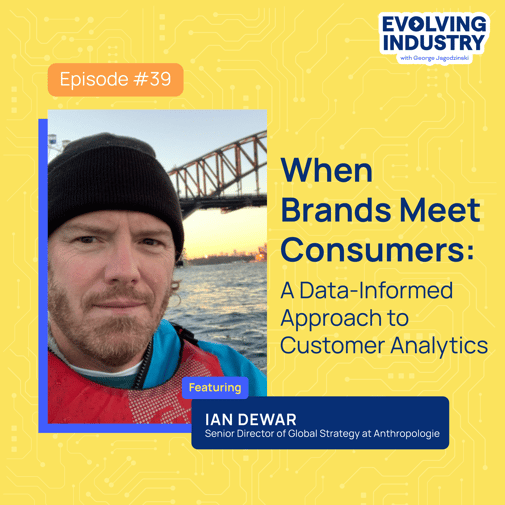Evolving Industry
Customer analytics is the heartbeat of modern businesses, providing valuable insights into consumer behavior, preferences, and market trends.
But once an organization dives into the deep end of the data pool, what happens next?
To answer that question, we chatted with Ian Dewar, Senior Director of Global Strategy at Anthropologie, about how he and his team have been leveraging data to enhance the customer experience.
Ian talked with us about:
- Why all the data you need for customer analytics is under your nose
- A data-informed approach to building customer loyalty
- How data analytics can promote collaboration across internal functions
Your Customer Analytics Data May Be Within Your Reach
Nowadays, big data is a big business all on its own. An International Data Corporation report estimated that international spending on data analytics solutions reached $215 billion in 2021 alone.
While at North Face, Ian and his team were concerned they’d have to drain their budget by buying relevant customer data from other businesses.
However, after working with an analytics partner to generate customer insights, they were blown away by the amount of data they already had in-house.
“That was really eye-opening to us,” he said. “And I think any brand could do that. Any brand could take that point of saying, ‘Hey, we’ve got customer databases in multiple places.’”
The issue wasn’t that the data sets they needed didn’t exist but that they were scattered across the company’s retail and e-commerce divisions.
“Any brand that has that direct-to-consumer component has a lot of their starting point data,” Ian said. “They just need to put it together into one place.”
So when organizations that feel like they’re behind the 8-ball scramble to compile customer data, how can they know when enough is enough?
“The first hurdle towards this consumer shift to consumer analytics is just taking the time to look at what you have and starting there, and recognizing that no brand knows everything about the customer,” Ian cautioned. “No brand knows everything about where you are, knows everything about what you buy, [or] knows everything about your behavior.”
A Data-Informed Approach to Customer Loyalty
One of the key takeaways from our conversation was that customer analytics helps retailers connect with their consumers on a deeper level.
“We want to understand our customers [who] are engaging with us most, and the customers engaging with us most are giving us the most data,” Ian told us.
Anthropologie, a brand known for its unique and creative offerings, emphasizes data analytics as a vehicle to maintain customer loyalty.
"Our customers really look at the uniqueness of Anthropologie and see it as a store that's different from everywhere else,” Ian said. “They like to tell us about why they like it.”
And that’s why Ian emphasized that data in a vacuum isn’t enough. Businesses have to listen to their customers so they can weigh customer analytics against intent.
“One of the things that gets lost sometimes in quantitative analytics around customer behavior is you're analyzing what the customer did, not what they wanted to do,” Ian advised.
Ian believes that what sets Anthropologie apart is its commitment to acting on customer feedback, which promotes further engagement. And that, ultimately, generates more relevant data.
“I liken this sometimes to how you have personal relationships. You want to be friends with the people who want to be friends with you, and you like to have conversations with the people who are interested in what you're talking about. And our businesses are the same.”
Customer Analytics and Internal Partnerships
Collaboration is key to the successful application of customer analytics, especially in organizations with diverse functional groups that may see each other as competition.
"It's a challenge because there is generally a strong point of view on communication strategy and product strategy," Ian said.
Balancing these perspectives requires open communication and a willingness to collaborate.
Ian underscored that internal business units can’t allow their strategic priorities to blind them from their ultimate goal — delighting customers.
“It's not on us to tell our customers where to shop. It's on us to make that shopping experience easier, no matter where they want to shop.”
He’s seen firsthand at Anthropologie how this synergy between creative insights and data-driven strategies can lead to remarkable outcomes. It’s just a matter of getting everyone on the same page with a data-informed approach.
"Analysts get focused on what they see the data saying and not necessarily how the business can use that data,” Ian stated. “And so, having that partnership with the business and on the marketing side, having that partnership with the creative side of it, that’s where the art and science need to work together."
Craving more? You can find this interview and many more by subscribing to Evolving Industry on Apple Podcasts, on Spotify, or here.
